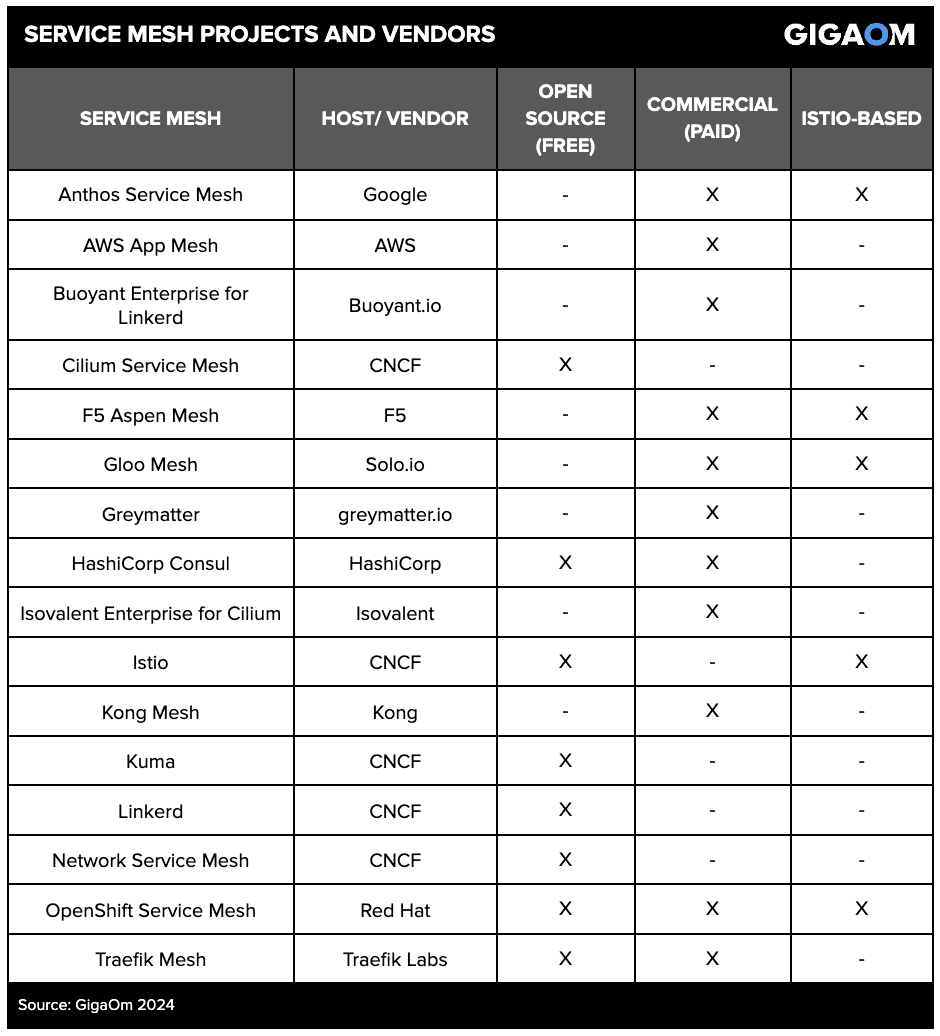Table of Contents
- Executive Summary
- Market Categories and Deployment Types
- Decision Criteria Comparison
- GigaOm Radar
- Solution Insights
- Analyst’s Outlook
- Methodology
- About Ivan McPhee
- About GigaOm
- Copyright
1. Executive Summary
Service mesh technology has emerged as an essential infrastructure layer for managing communication between microservices, which are the building blocks of modern, scalable applications deployed in cloud environments. As organizations transition from monolithic to microservices architectures, the complexity of managing service-to-service interactions increases significantly. A service mesh addresses this complexity by providing a transparent and consistent way to secure, connect, and observe microservices without requiring changes to the application code.
Purpose of a Service Mesh
The primary purpose of a service mesh is to facilitate and manage the communication among dozens or even hundreds of microservices that make up a distributed application architecture. Without a service mesh, managing these interactions can become overwhelmingly complex. Key functionalities of a service mesh include:
- Traffic management: It controls the way requests are routed and managed between services, supporting capabilities like load balancing, canary releases, and A/B testing. This allows for fine-grained control over traffic, which is crucial for optimizing application performance and rolling out updates safely.
- Security: It provides robust security features, such as mutual transport layer security (mTLS) for encrypted communications, fine-grained access control policies, and authentication and authorization mechanisms. These features help ensure that communications between services are secure from unauthorized access and potential threats.
- Observability: It offers rich observability features, including logging, monitoring, and tracing of requests that flow through the mesh. This visibility is critical for diagnosing and troubleshooting issues, understanding system performance, and ensuring that the application runs smoothly and efficiently.
Why Adopting a Service Mesh Is Important
The importance of a service mesh stems from its ability to abstract the complexity of inter-service communications into a dedicated infrastructure layer. This abstraction allows developers to focus on building business logic rather than dealing with the intricacies of network and security policies. As applications grow and the number of services increases, a service mesh becomes crucial for maintaining control and visibility over these complex interactions. Implementing a service mesh ensures that applications remain robust, secure, and easy to manage, regardless of scale.
Open source projects and commercial vendors target a wide range of application environments and deployment options. Figure 1 lists the open source and commercial service meshes that are included in this report, along with their acquisition options.
Figure 1. Service Mesh Projects and Vendors
Note: The Cloud Native Computing Foundation (CNCF) provides governance for open source, vendor-neutral cloud-native projects. It hosts several community-driven open source projects with varying maturity levels: sandbox (early stage), incubating (stable), or graduated (widely deployed in production environments).
How the Service Mesh Landscape is Evolving
The concept of a service mesh has evolved significantly since its inception. Early iterations were primarily focused on providing basic service discovery and load balancing. However, as cloud-native technologies like containers and orchestration tools like Kubernetes became mainstream, the role of service meshes has expanded to include more sophisticated traffic management, enhanced security, and comprehensive observability.
- Improved usability: Initially, service meshes were complex to configure and manage. Recent developments have focused on enhancing the user experience with more intuitive interfaces, automated setup processes, integration with existing cloud-native ecosystems, and better documentation. These features lower the barrier to entry, making service meshes accessible to a broader range of users.
- Performance optimization: Modern service meshes are being designed to minimize latency and resource overhead. Innovations such as sidecarless deployments and the integration of cutting-edge technologies like ambient mesh and eBPF have the potential to reduce latency and resource consumption, minimizing the performance impact traditionally associated with service meshes.
- Standardization and interoperability: As the service mesh landscape grows, there has been a push towards standardization to ensure compatibility and interoperability between different service mesh technologies. Initiatives like the Kubernetes Gateway API aim to create a standard set of APIs, making it easier for users to switch between service meshes or use multiple meshes within the same environment.
- Expansion into new areas: Service meshes are now beginning to extend beyond traditional cloud and microservices environments into areas like serverless computing and edge computing. This expansion opens up new use cases and opportunities for innovation.
In conclusion, a service mesh simplifies the management of complex service interactions and enhances application security and observability. As the technology continues to evolve, it will play an increasingly critical role in enabling organizations to scale, secure, and optimize their applications efficiently.
This is our fourth year evaluating the service mesh space in the context of our Key Criteria and Radar reports. This report builds on our previous analysis and considers how the market has evolved over the last year.
This GigaOm Radar report examines 16 of the top service mesh solutions and compares each solution against the capabilities (table stakes, key features, and emerging features) and nonfunctional requirements (business criteria) outlined in the companion Key Criteria report. Together, these reports provide an overview of the market, identify leading service mesh offerings, and help decision-makers evaluate these solutions so they can make a more informed investment decision.
GIGAOM KEY CRITERIA AND RADAR REPORTS
The GigaOm Key Criteria report provides a detailed decision framework for IT and executive leadership assessing enterprise technologies. Each report defines relevant functional and nonfunctional aspects of solutions in a sector. The Key Criteria report informs the GigaOm Radar report, which provides a forward-looking assessment of vendor solutions in the sector.
